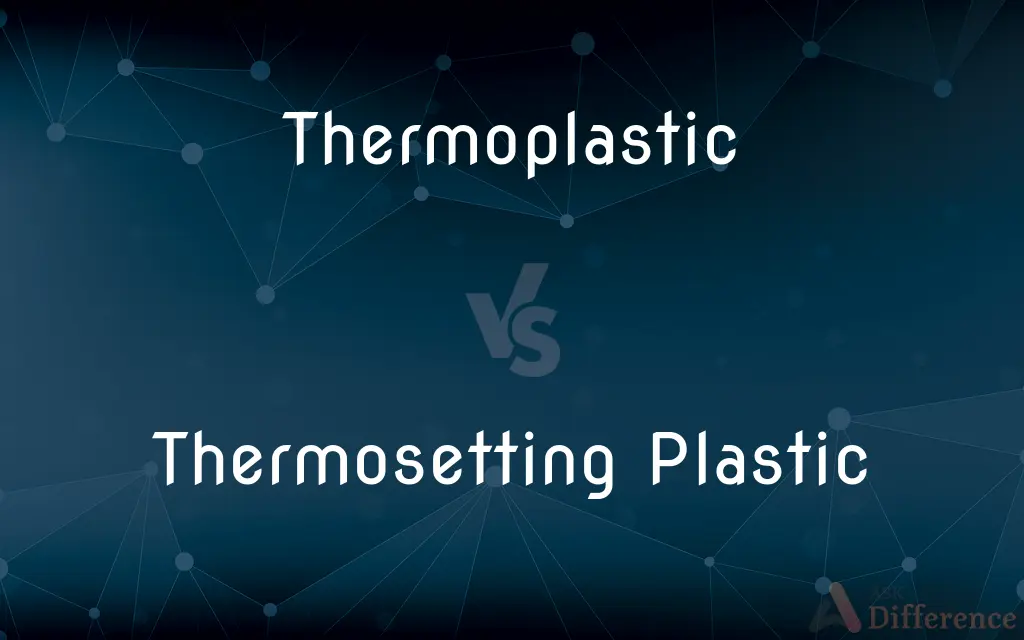Thermoplastic vs. Thermosetting Plastic — What's the Difference?
By Tayyaba Rehman — Published on January 8, 2024
Thermoplastics soften with heat and can be reshaped, while thermosetting plastics harden permanently when heated and cannot be remolded.

Difference Between Thermoplastic and Thermosetting Plastic
Table of Contents
ADVERTISEMENT
Key Differences
Thermoplastic materials soften when heated and harden upon cooling, allowing them to be remolded multiple times. In contrast, thermosetting plastics undergo a chemical change when heated, resulting in a rigid, permanent structure.
In thermoplastics, the polymer chains are not cross-linked, making them flexible and meltable. On the other hand, thermosetting plastics form strong cross-links between polymer chains when heated, which are irreversible.
Thermoplastics are widely used due to their recyclability and remoldability. However, thermosetting plastics are chosen for their durability and heat resistance, but they cannot be recycled like thermoplastics.
Applications of thermoplastics include water bottles, packaging, and toys, thanks to their malleability. Thermosetting plastics are utilized in electrical insulation, adhesives, and auto parts due to their structural stability.
Both types of plastics have distinct properties and uses, with thermoplastics being versatile and thermosetting plastics providing robust, heat-resistant options.
ADVERTISEMENT
Comparison Chart
Heat Response
Softens with heat, hardens when cooled
Hardens permanently when heated
Reusability
Can be remolded and recycled
Cannot be reshaped or recycled
Polymer Chain Structure
Linear or slightly branched, no cross-links
Heavily cross-linked
Mechanical Properties
Generally less rigid, more flexible
Rigid and heat resistant
Common Applications
Packaging, toys, water bottles
Electrical components, adhesives, auto parts
Compare with Definitions
Thermoplastic
Linear polymer chains, flexible when heated.
Thermoplastic bags become pliable with heat, allowing easy shaping.
Thermosetting Plastic
Non-recyclable, heat-resistant plastic.
Thermosetting plastic used in car parts remains stable even under high temperatures.
Thermoplastic
Softens with heat, hardens when cooled.
A thermoplastic water bottle can be melted down and remolded into a new product.
Thermosetting Plastic
Hardens permanently with heat.
Once set, a thermosetting plastic handle on a cooking utensil cannot be remolded.
Thermoplastic
Recyclable, remoldable plastic.
Used thermoplastic packaging can be reheated and transformed into plastic containers.
Thermosetting Plastic
Irreversibly hardens, forming a strong structure.
Thermosetting plastic adhesives harden permanently, providing a strong bond.
Thermoplastic
Heat-sensitive, meltable plastic.
Thermoplastic phone cases can be melted and recycled into new plastic products.
Thermosetting Plastic
Cross-linked, rigid plastic.
Thermosetting plastic is used in electrical switches due to its durability and heat resistance.
Thermoplastic
Reusable plastic material.
Broken thermoplastic toys can be melted and reshaped into new toys.
Thermosetting Plastic
Non-meltable, structurally stable plastic.
Thermosetting plastic used in kitchenware can withstand high cooking temperatures without melting.
Thermoplastic
Becoming soft when heated and hard when cooled.
Thermoplastic
A thermoplastic resin, such as polystyrene or polyethylene.
Thermoplastic
Softening when heated and hardening when cooled, and thus able to be moulded
Thermoplastic
A plastic with this property.
Thermoplastic
A material that softens when heated and hardens again when cooled
Thermoplastic
Having the property of softening or fusing when heated and of hardening and becoming rigid again when cooled;
Thermoplastic materials can be remelted and cooled time after time without undergoing any appreciable chemical change
Common Curiosities
Can thermosetting plastics be remolded?
No, once set, thermosetting plastics cannot be remolded.
Why are thermosetting plastics heat resistant?
The cross-linked polymer chains in thermosetting plastics provide high heat resistance.
Can thermoplastics withstand high temperatures?
They soften with heat, so they are less heat resistant compared to thermosetting plastics.
Are thermoplastics recyclable?
Yes, thermoplastics can be remelted and reshaped, making them recyclable.
What makes thermoplastics flexible?
Their linear or slightly branched polymer chains without cross-links provide flexibility.
What makes thermosetting plastics different in structure?
They have heavily cross-linked polymer chains, providing rigidity.
Are thermoplastics cheaper than thermosetting plastics?
Typically, yes, due to their ease of manufacturing and recycling.
Do thermosetting plastics have any disadvantages?
Their inability to be reshaped or recycled can be seen as a disadvantage.
What are common uses of thermoplastics?
Packaging, toys, and water bottles are common applications.
Are thermosetting plastics used in electronics?
Yes, their durability and heat resistance make them suitable for electrical components.
Is the recycling of thermoplastics environmentally beneficial?
Yes, recycling thermoplastics reduces waste and conserves resources.
Do thermoplastics lose their properties when remolded?
Generally, they retain their properties, but repeated recycling can degrade quality.
Can thermoplastics be used for high-strength applications?
While less rigid than thermosetting plastics, some high-strength thermoplastics are suitable for such applications.
Can thermosetting plastics be used in automobiles?
Yes, their strength and heat resistance make them suitable for auto parts.
Why can't thermosetting plastics be recycled?
Their permanent, cross-linked structure makes them non-meltable and non-recyclable.
Share Your Discovery

Previous Comparison
Applet in Java vs. Servlet in Java
Next Comparison
28 States vs. 8 UTAuthor Spotlight
Written by
Tayyaba RehmanTayyaba Rehman is a distinguished writer, currently serving as a primary contributor to askdifference.com. As a researcher in semantics and etymology, Tayyaba's passion for the complexity of languages and their distinctions has found a perfect home on the platform. Tayyaba delves into the intricacies of language, distinguishing between commonly confused words and phrases, thereby providing clarity for readers worldwide.













































